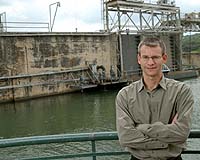| . |  |
. |
Moffett Field CA (SPX) Aug 26, 2010 The most robust statistical examination to date of our species' genetic links to "mitochondrial Eve", the maternal ancestor of all living humans, confirms that she lived about 200,000 years ago. The Rice University study was based on a side-by-side comparison of 10 human genetic models that each aim to determine when Eve lived using a very different set of assumptions about the way humans migrated, expanded and spread across Earth. The research is available online in the journal Theoretical Population Biology. "Our findings underscore the importance of taking into account the random nature of population processes like growth and extinction," said study co-author Marek Kimmel, professor of statistics at Rice. "Classical, deterministic models, including several that have previously been applied to the dating of mitochondrial Eve, do not fully account for these random processes." The quest to date mitochondrial Eve (mtEve) is an example of the way scientists probe the genetic past to learn more about mutation, selection and other genetic processes that play key roles in disease. "This is why we are interested in patterns of genetic variability in general," Kimmel said. "They are very important for medicine." For example, the way scientists attempt to date mtEve relies on modern genetic techniques. Genetic profiles of random blood donors are compared, and based upon the likenesses and differences between particular genes, scientists can assign a number that describes the degree to which any two donors are related to one another. Using mitochondrial genomes to gauge relatedness is a way for geneticists to simplify the task of finding common ancestors that lived long ago. That is because the entire human genome contains more than 20,000 genes, and comparing the differences among so many genes for distant relatives is problematic, even with today's largest and fastest supercomputers. But mitochondria - the tiny organelles that serve as energy factories inside all human cells - have their own genome. Besides containing 37 genes that rarely change, they contain a "hypervariable" region, which changes fast enough to provide a molecular clock calibrated to times comparable to the age of modern humanity. Because each person's mitochondrial genome is inherited from his or her mother, all mitochondrial lineages are maternal. To infer mtEve's age, scientists must convert the measures of relatedness between random blood donors into a measure of time. "You have to translate the differences between gene sequences into how they evolved in time," said co-author Krzysztof Cyran, vice head of the Institute of Informatics at Silesian University of Technology in Gliwice, Poland. "And how they evolved in time depends upon the model of evolution that you use. So, for instance, what is the rate of genetic mutation, and is that rate of change uniform in time? And what about the process of random loss of genetic variants, which we call genetic drift?" Within each model, the answers to these questions take the form of coefficients - numeric constants that are plugged into the equation that returns the answer for when mtEve lived. Each model has its own assumptions, and each assumption has mathematical implications. To further complicate matters, some of the assumptions are not valid for human populations. For example, some models assume that population size never changes. That is not true for humans, whose population has grown exponentially for at least several thousand generations. Other models assume perfect mixing of genes, meaning that any two humans anywhere in the world have an equal chance of producing offspring. Cyran said human genetic models have become more complex over the past couple of decades as theorists have tried to correct for invalid assumptions. But some of the corrections, like adding branching processes that attempt to capture the dynamics of population growth in early human migrations are extremely complex. Which raises the question of whether less complex models might do equally well in capturing what's occurring. "We wanted to see how sensitive the estimates were to the assumptions of the models," Kimmel said. "We found that all of the models that accounted for random population size, such as different branching processes gave similar estimates. This is reassuring, because it shows that refining the assumptions of the model, beyond a certain point, may not be that important in the big picture."
Share This Article With Planet Earth
Related Links Theoretical Population Biology All About Human Beings and How We Got To Be Here
 Humans Trump Nature On Texas River
Humans Trump Nature On Texas RiverHouston TX (SPX) Aug 24, 2010 A new study by geochemists at Rice University finds that damming and other human activity has completely obscured the natural carbon dioxide cycle in Texas' longest river, the Brazos. "The natural factors that influence carbon dioxide cycling in the Brazos are fairly obvious, and we expected the radiocarbon signature of the river to reflect those influences," said study co-author Caroline ... read more |
|
| The content herein, unless otherwise known to be public domain, are Copyright 1995-2010 - SpaceDaily. AFP and UPI Wire Stories are copyright Agence France-Presse and United Press International. ESA Portal Reports are copyright European Space Agency. All NASA sourced material is public domain. Additional copyrights may apply in whole or part to other bona fide parties. Advertising does not imply endorsement,agreement or approval of any opinions, statements or information provided by SpaceDaily on any Web page published or hosted by SpaceDaily. Privacy Statement |